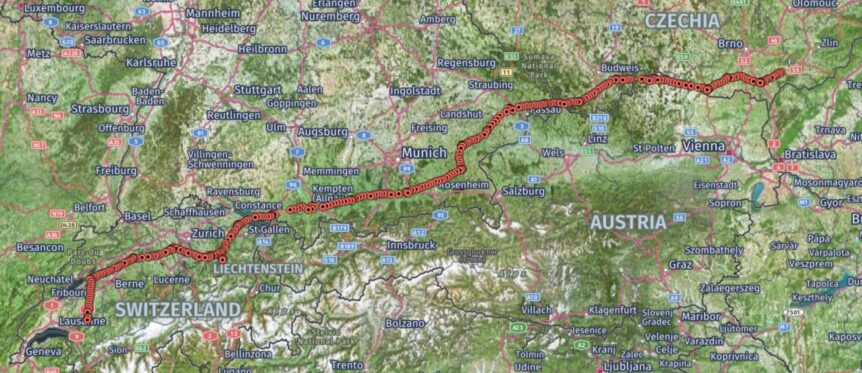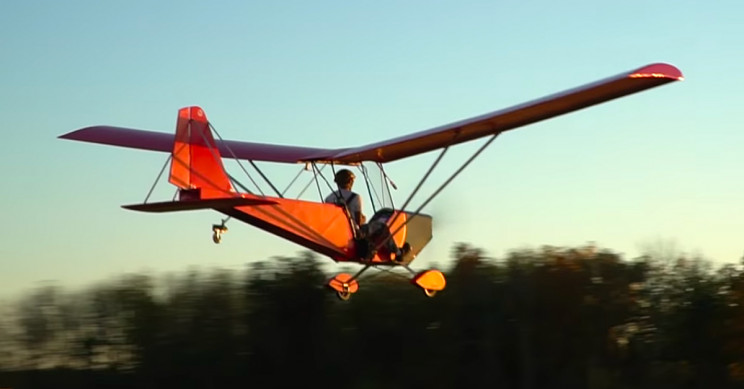Your editor is publishing this multi-country adventure from Daniel Ramsier recounting of his 1,000 kilometer trip in an electric microlight, with some of his outstanding photographs. It’s a truly epic outing that shows ingenuity, great engineering, and a resolute spirit combined to show how much can be accomplished with a very small material involvement. The story highlights Paul MacCready’s advice to do more with much less. Regardless that it was leisurely journey, averaging 25 kilometers (15.5 miles) per day, it was still a test of Daniel’s hardihood and his craft’s reliability. Yes, it’s definitely possible to fly and travel “electric”. Taking off from Gruyère (LSGT) in Switzerland on July 15, I arrived in Kyjov in the Czech Republic in 40 days and 22 legs, invited by Marek Wolhard, a paraplegic 3-axis ultralight instructor pilot who had followed @handiflight around the world. My nano-trike was developed by Ales Hubacek of skyjam-aircraft.com in Zurich. Light and strong, made entirely of titanium, its very …
Peter Sripol’s Mk. IV is Paramotor Powered
Peter Sripol creates interesting ultralight aircraft, among other, sometimes scary projects. His latest is pulled along by a paramotor motor. Because of the small aircraft’s low and slow performance, the low-power (and very low noise) motor seems more than sufficient to the task. His fourth design, the Mk IV has no ailerons, much like an earlier ultralight, the Skypup. After initial tests showed shortcomings with the Mk. IV, quickly modified wings allowed Peter to return to the air quickly. As he explains, there won’t be plans for this airplane because it has too many not as yet time-tested innovations. The hot-wire-cut foam structure and vinyl wrapped wings are an unknown in terms of longevity, so it’s probably best to let Peter make his determination on that. Note the machine seems to be remarkably quiet, the OpenPPG motor drowned out by propeller noise. (That’s also low because of the e-Prop’s design.)* When Peter is able to shout down to his father …
A Swan among the Ultralights
At this year’s Aero Friedrichshafen, Modern Wings showed off their Swan Ultralight, a nicely packaged machine that can fly on either fossil fuels or electricity. Of course, we’ll feature the electric version here. The Swan E115-22 is an electrically-powered airplane of 115 kilograms (253 pounds) empty weight powered by a 22-horsepower motor. That empty weight puts it solidly into U. S. FAR Part 103 territory and SSDR (single-seat deregulated) requirements in Great Britain, and a 120 kilogram (264 pound) version complies with Regulation 120 in Germany. Maximum takeoff weight is 300 kilograms (660 pounds), heavier than the 524 pounds Part 103 allows, and possible legal depending on how local FAA inspectors view batteries as part of empty or total weight. Designers chose a high-wing, tractor-propeller configuration to help keep newcomers out of trouble, and crafted a nicely streamlined pod and boom with neatly faired landing gear. This helps enclose the pilot, “…For smooth, pleasant flights without a heavy and expensive …
A New Entry in Electric Para-Gliding
EV World announced a new electric para-motor, complete with a new motor, composite mounts, and a series of battery pack setups. Made in France, a complete setup with parasail, motor, controller, batteries and controls costs 14,210 euros ($16,057). This may seem pricey, but consider that a paramotor can be carried in a pickup or SUV, needs no airport, and is truly “free flight,” avoiding a lot of the rules that encumber much of general aviation. George Blottin, the founder of Aeronature, a parasail and paramotor training site in southern France, wanted something that would avoid the noise and occasional failure of two-and-four-stroke engines. Electric motors fit that bill, and he worked with a participant on the Airbus e-Fan project to create one that met the specialized needs of paramotoring. His firm, Exomo, can provide the 15 kilowatt motor with a variety of battery packs, ranging from a 15-minute, 25 Amp-hour unit, through a 30- to 45-minute, 45 Amp-hour pack to …
EAS IX: Chip Erwin Gets Personal with Electric Flying
Light Sport Aircraft (LSA), alas, haven’t lived up to their early hype, 100 manufacturers selling only 235 units in the United States last year. That bothers Chip Erwin, who would like a Personal Sport Aircraft (PSA) option. He’s working through his company, Aeromarine LSA, to do something about that. Chip explains that high prices for LSAs, brought on by doubling Rotax prices over the last decade and quadrupling of once cheap European labor rates, has put what were to be $50,000 airplanes into the $150,000 price range, barely able to compete with used Cessnas and Pipers. Having demonstrated two-stroke engines and an Electravia motor on his imported Zigolo ultralight glider, he has displayed an alternative motor designed by Don Lineback, first at last year’s AirVenture as a mockup, then as an operating prototype at the ninth Annual Electric Aircraft Symposium in May. Now he’s displaying it at AirVenture 2015, complete with an e-Prop four-blade, asymmetric propeller reputed to cut noise. …
Hungarian Flying Trike Makes Debut
This six-rotored, six-motored flying “Y” may make you ask “why, indeed,” but its makers are enthusiastic about its prospects. Even though its second test flight lasted only a minute and a half, its rider looked as happy as though he’d just ridden the mechanical bull at Gilley’s. Certainly the riding posture is similar, and the Flike (flying trike) might show more three-dimensional moves than the beast tethered to the barroom’s floor. https://www.youtube.com/watch?v=CmiMx7ClcSI Flike’s designers and builders are funded by a major Hungarian government-based non-profit organization dedicated, it would seem, to emerging technologies in biological, engineering, and environmental sciences, among others. The six NT-Power motors are probably the 15 kilowatt units (the other option is a 12 kW version), with maximum input of 80 Volts and 280 Amperes. Motor efficiency is 93 percent, but the company shows total system efficiency with battery, controllers, cables, connectors and other components of about 88 percent. This might be a good disclosure approach for all motor vendors. …
Academy Award Winner, Legion of Honor Recipient Conquer the Channel
Anne Lavrand, head of Electravia, shared this news in her blog this morning. Following its initial flight at the Coupe Icare in 2011, the electric airship Iris Challenger was slated to make a cross-English Channel attempt later that year. Unfortunately, prevailing winds prevailed against that November attempt between Dover and Calais. Patience and careful planning finally paid off for pilots Pierre Chabert and Gerard Feldzer, though, and today, they made the crossing from France to Dymchurch, England in two hours and 23 minutes. Built by Airstar (Chabert is founder and president/CEO of the company), the envelope contains 568 cubic meters (20,059 cubic feet) of helium, and can carry a payload of 200 kilograms (440 pounds). Equipped with two electric motors of seven kilowatts (9.38 horsepower) each, and two counter-rotating 1.3 meter (51.1875 inch) propellers made by E-Props, the 14 meter (46 feet), six meter high envelope navigates at a cruising speed of 15 kilometer per hour (9.3 mph). Its lithium …
Paramotors Get Own Web Site – And It Speaks French
Anne Lavrand of Electravia in Sisteron, France has announced a new web site, dedicated to her company’s electric powered paragliders (PPG). Initially, the new web site will promote Electravia’s e-Spider Mono ultralight powered parachute, a 23 kilogram (50.6 pounds) package with: • A 17 horsepower electric motor and controller, an e-Screen, three-inch LED display showing motor and battery status. • an e-Props 1.6 meter (5.25 feet) propeller in Electravia’s unique QD2 arrangement, which offsets blade angles to generate more thrust and less noise. • a Kokam lithium-polymer battery pack (1.55 kWh), with battery management system (BMS) and protection circuit module (PCM). • a charger for lithium-polymer batteries. • a 1.6 meter diameter aluminum hexagonal cage, weighing only 4 kilograms (8.8 pounds). With a flight duration of 35 minutes, the Mono is a good choice for PPG schools, according to Ms. Lavrand. It allows short flights for students, is quiet, simple for novices to start, and relatively inexpensive for flight schools to …
Electravia Makes a Good Showing at Aero Expo
Anne Lavrand, founder and President of Electravia, continues to find ways to expand her company’s product offerings while offering well-integrated packages of reasonably-priced electric aircraft and components. At this year’s Aero Expo in Friedrichshafen, Germany, her firm displayed the fuselage of the Electrolight 2, a modified Fauconnet sailplane, fitted with a 30-hp Lynch-type motor, controller, and batteries. It is the least expensive electric motorglider on the market at only 30,000 Euros ($39,600), and allows powered flight for recharging costs of about 0.65 Euros per hour (86 cents). The motor, normally graced by one of Anne’s wooden e-Props, had a forward-folding “clap propeller” or “bec de canard” (literally, the beak of the duck), a variant on the light carbon fiber propellers that e-Props also produces. This should reduce drag and help improve the performance of the Fauconnet, a French version of the popular Scheibe L-Spatz, which Anne notes was flown by every young German learning to fly sailplanes a few years …
Electravia, Cri-Cri Set Speed Record at Paris Air Show
Anne Lavrand of Electravia in Grenoble, France, shares this exciting news from the Paris Air Show today. “A new speed world record for electric aircraft : 283 km/h ! (175.46 mph) “Hugues Duval holds the world speed record for an electrically powered aircraft after reaching the top speed of 283 km/h during his presentation flight today in the 49th Paris Air Show (Saturday 25th of June, 2011). “This electric Cri-Cri is powered by two electric propulsion systems ELECTRAVIA (35 HP each), two special high-speed propellers E-PROPS and 3 kWh of KOKAM Lithium-Polymer batteries (24 kg). “This flight has shown to key actors of [the] aeronautics world present at [the] Paris Air Show 2011 that electric engines are a real alternative way of propulsion.” Coming from the light aircraft, rather than the Airbus world, the flight affirms that inventive small firms have an opportunity to show the way in this exciting new technology. For a French TV news highlight of the …
- Page 1 of 2
- 1
- 2


